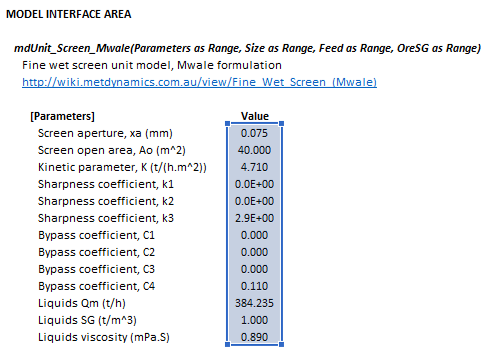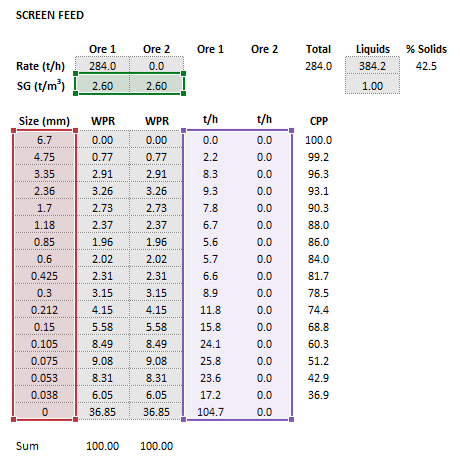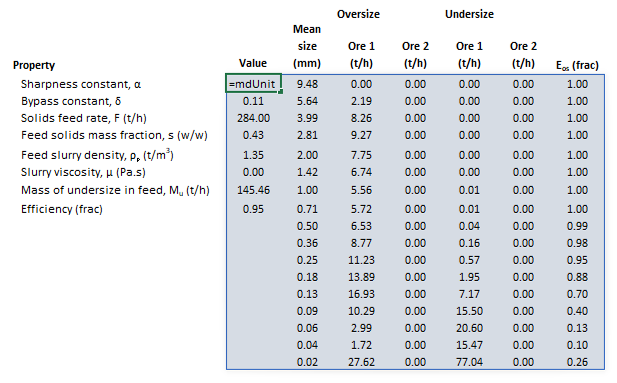Fine Wet Screen (Mwale): Difference between revisions
Jump to navigation
Jump to search
Scott Munro (talk | contribs) m (1 revision imported) |
md>Scott.Munro m (→Excel) |
||
| Line 8: | Line 8: | ||
== Excel == | == Excel == | ||
The Mwale fine wet screen model may be invoked from the Excel formula bar with the following function call: | The Mwale fine wet screen model may be invoked from the Excel formula bar with the following function call: | ||
| Line 16: | Line 14: | ||
{{Excel (Text, Help, No Arguments)}} | {{Excel (Text, Help, No Arguments)}} | ||
=== Inputs === | |||
{{Excel (Text, Inputs)}} | |||
:<math>Parameters= | |||
\begin{bmatrix} | |||
K\text{ (t/h.m}^2\text{)}\\ | |||
\delta\text{ ((t/h)}^{-1}\text{)}\\ | |||
\alpha\text{ (-)}\\ | |||
A_{\rm o}\text{ (m}^2\text{)}\\ | |||
x_{\rm a} \text{ (mm)}\\ | |||
s\text{ (w/w)}\\ | |||
\end{bmatrix},\;\;\;\;\;\; | |||
Size = \begin{bmatrix} | |||
d_{1}\text{ (mm)}\\ | |||
\vdots\\ | |||
d_n\text{ (mm)}\\ | |||
\end{bmatrix},\;\;\;\;\;\; | |||
Feed= \begin{bmatrix} | |||
(Q_{\rm M,F})_{11}\text{ (t/h)} & \dots & (Q_{\rm M,F})_{1m}\text{ (t/h)}\\ | |||
\vdots & \ddots & \vdots\\ | |||
(Q_{\rm M,F})_{n1}\text{ (t/h)} & \dots & (Q_{\rm M,F})_{nm}\text{ (t/h)}\\ | |||
\end{bmatrix} | |||
</math> | |||
where: | |||
* <math>K</math> is the kinetic parameter (t/h.m<sup>2</sup>) | |||
* <math>\delta</math> is a bypass parameter ((t/h)<sup>-1</sup>) | |||
* <math>\alpha</math> is the sharpness parameter (-) | |||
* <math>A_{\rm o}</math> is the screen open area (m<sup>2</sup>) | |||
* <math>x_{\rm a}</math> is the screen aperture (mm) | |||
* <math>s</math> is the mass fraction of solids in the feed slurry (w/w) | |||
* <math>n</math> is the number of size intervals | |||
* <math>d_i</math> is the size of the square mesh interval that feed mass is retained on (mm) | |||
* <math>d_{i+1}<d_i<d_{i-1}</math>, i.e. descending size order from top size (<math>d_{1}</math>) to sub mesh (<math>d_{n}=0</math> mm) | |||
* <math>m</math> is the number of ore types | |||
* <math>Q_{\rm M,F}</math> is feed solids mass flow rate by size and ore type (t/h) | |||
=== Results === | |||
The results are displayed in Excel as an array corresponding to the matrix notation below: | |||
:<math> | |||
\mathit{mdUnit\_Screen\_Mwale} = | |||
\begin{bmatrix} | |||
\begin{array}{c} | |||
\begin{bmatrix} | |||
E_{\rm US}\\ | |||
\end{bmatrix} | |||
\\ | |||
\\ | |||
\\ | |||
\end{array} | |||
& | |||
\begin{bmatrix} | |||
\bar d_1\text{ (mm)}\\ | |||
\vdots\\ | |||
\bar d_n\text{ (mm)} | |||
\end{bmatrix} | |||
& | |||
\begin{bmatrix} | |||
(Q_{\rm M,OS})_{11}\text{ (t/h)} & \dots & (Q_{\rm M,OS})_{1m}\text{ (t/h)}\\ | |||
\vdots & \ddots & \vdots\\ | |||
(Q_{\rm M,OS})_{n1}\text{ (t/h)} & \dots & (Q_{\rm M,OS})_{nm}\text{ (t/h)}\\ | |||
\end{bmatrix} | |||
& | |||
\begin{bmatrix} | |||
(Q_{\rm M,US})_{11}\text{ (t/h)} & \dots & (Q_{\rm M,US})_{1m}\text{ (t/h)}\\ | |||
\vdots & \ddots & \vdots\\ | |||
(Q_{\rm M,US})_{n1}\text{ (t/h)} & \dots & (Q_{\rm M,US})_{nm}\text{ (t/h)}\\ | |||
\end{bmatrix} | |||
& | |||
\begin{bmatrix} | |||
(E_{\rm oa})_1\text{ (frac)}\\ | |||
\vdots\\ | |||
(E_{\rm oa})_n\text{ (frac)} | |||
\end{bmatrix} | |||
\end{bmatrix} | |||
</math> | |||
where: | |||
* <math>E_{\rm US}</math> is the efficiency of undersize removal achieved by the screen (frac) | |||
* <math>\bar d_{i}</math> is the [[Conversions|geometric mean size]] of particles in size interval <math>i</math> (mm) | |||
* <math>Q_{\rm M,OS}</math> is mass flow rate of solids to the oversize stream (t/h) | |||
* <math>Q_{\rm M,US}</math> is mass flow rate of solids to the undersize stream (t/h) | |||
* <math>E_{\rm oa}</math> is the partition to oversize (frac) | |||
=== Example === | |||
The images below show the selection of input arrays and output results in the Excel interface. | |||
{| | |||
|- style="vertical-align:top;" | |||
| [[File:FineWetScreenMwale1.png|left|frame|Figure 1. Example showing the selection of the '''Parameters''' (blue frame) array in Excel.]] | |||
| [[File:FineWetScreenMwale2.png|left|frame|Figure 2. Example showing the selection of the '''Size''' (red frame), and '''Feed''' (purple frame) arrays in Excel.]] | |||
| [[File:FineWetScreenMwale3.png|left|frame|Figure 3. Example showing the outline of the '''Results''' (light blue frame) array in Excel.]] | |||
|} | |||
== SysCAD == | == SysCAD == | ||
Revision as of 09:49, 15 May 2023
Description
This article describes an implementation of the Mwale (Mwale et al., 2016) model for fine wet screening.[1]
Model theory
Excel
The Mwale fine wet screen model may be invoked from the Excel formula bar with the following function call:
=mdUnit_Screen_Mwale(Parameters as Range, Size as Range, Feed as Range)
Invoking the function with no arguments will print Help text associated with the model, including a link to this page.
Inputs
The required inputs are defined below in matrix notation with elements corresponding to cells in Excel row () x column () format:
where:
- is the kinetic parameter (t/h.m2)
- is a bypass parameter ((t/h)-1)
- is the sharpness parameter (-)
- is the screen open area (m2)
- is the screen aperture (mm)
- is the mass fraction of solids in the feed slurry (w/w)
- is the number of size intervals
- is the size of the square mesh interval that feed mass is retained on (mm)
- , i.e. descending size order from top size () to sub mesh ( mm)
- is the number of ore types
- is feed solids mass flow rate by size and ore type (t/h)
Results
The results are displayed in Excel as an array corresponding to the matrix notation below:
where:
- is the efficiency of undersize removal achieved by the screen (frac)
- is the geometric mean size of particles in size interval (mm)
- is mass flow rate of solids to the oversize stream (t/h)
- is mass flow rate of solids to the undersize stream (t/h)
- is the partition to oversize (frac)
Example
The images below show the selection of input arrays and output results in the Excel interface.
SysCAD
References
- ↑ Mwale, A.N., Mainza, A.N., Bepswa, P.A., Simukanga, S., Masinja, J.H., 2016. MODEL FOR FINE WET SCREENING. In XXVIII International Mineral Processing Congress Proceedings. Canadian Institute of Mining, Metallurgy and Petroleum.
























